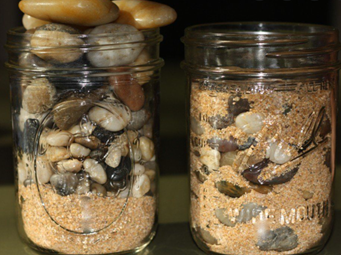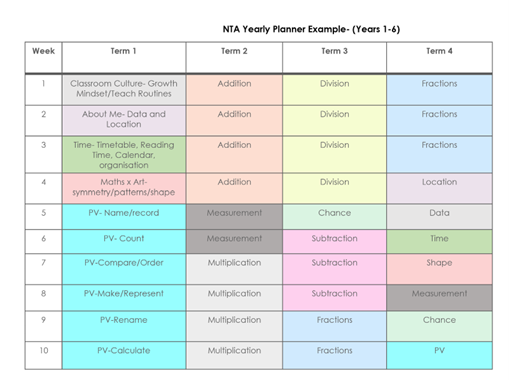Yearly Planning
Aug 26, 2022
I wanted to talk about yearly planning because as we begin Term 4- we naturally start focussing on the year ahead. Sometimes yearly planning can be a challenge, but it is a really important first step in making sure that everyone at your school is on the same page.
Often I'm asked about creating ‘Scope and Sequence’ documents. In my opinion, before you even look at a ‘Scope and Sequence’, it is important to have a solid Yearly Overview in place.
So, what is a yearly plan? Well, thanks for asking!
It basically covers every year level, and states the units or topics each group is going to teach at particular times. It is a high level planning document. All you need to include is the weeks for each term and a rough sketch of when each content area is going to be taught.
The purpose of a yearly overview is to ensure you are covering all the curriculum requirements of each year level, and you have an idea of how long you are going to spend on each area.
One of the difficulties with many curriculum documents is that they don’t provide any guidance on the weighting that should be given to each descriptor. Intuitively we know that descriptors that cover ‘meaty’ areas like place value need to be given more instructional time than a descriptor that looks at triangular numbers- not taking anything away from triangular numbers- you just don’t need to spend too long on them!
When I guide schools in their yearly planning, I talk about the importance of putting in the ’big rocks’ first.
If you look at the image below you will see what I mean.

If you start with the sand, pebbles and little rocks you will never fit in as much as if you begin by putting in place the ‘big rocks’ and filling around them.
So, what are our ‘big rocks’ in maths?
I consider these to be place value and the four operations (or put in another way- the big idea).
Around them I then fit in my measurement and geometry and statistics and probability topics.
When doing this, I don’t just randomly place topics wherever they will fit. I consider a few things:
- Time: How long I estimate I need to spend (this is a little bit of an educated guess, and depends a little on your school context- maybe your data suggests your students need a bit of a push in Geometry- so you might carve out some more time for this area)
- Connections: School events that might align with particular topics (for example, I always put measurement units in the week we have our athletics carnival because there is an authentic connection to be made there for students)
- Non-negotiables: I always begin the year with a 6 week place value unit where we spend one week looking at each of the 6 aspects of place value (see here for my blog on the 6 aspects)
- Integrated Learning: I have a look at the Inquiry topics that each year level is covering that year. If the Year Sixes are looking at ‘Space’ I might put in a maths unit around converting units of measurement or timetables (there is a great reSolve sequence of lesson that looks at space travel and timetables)
- Spread: I like to spread my big rocks out. So, for example in the Junior grades, I separate my teaching of addition and subtraction. I think this is important as it gives them a little time for the ideas and concepts to sink in. After Year 3, I want the students to be seeing the connection between addition and subtraction, so I schedule these units closer together (or sometimes even as one big unit). You might not agree with this, and that is ok... this is a school based decision you can make with your team!
- Time of Year: I also consider where we are in the year. In Term 1, we are building relationships with our students, and we are getting to know them. This is the perfect context for investigations involving gathering and presenting data, and location. You could be discussing favourite TV shows, the number of people in each family, the way they travel to school etc. They could be drawing maps of the classroom, exploring the fastest way to get to the office from the classroom. Term One is also an important time for working on developing a supportive learning environment, working on learning dispositions and growth mindset, so make sure there is time factored in for these critical sessions.
- Special Events: If it is an Olympic or Commonwealth Games year, I schedule my data and measurement units around those events. Again, the perfect authentic context for maths teaching!
- Resources: As the Numeracy Leader, I look across the school and consider our resources. For example, do I have enough scales for the whole school to be working on mass at the same time. These practical considerations are critical to ensure the year runs smoothly.
I have included a sample yearly planner here that I developed for my NTA members. You may like to use this as a guide for your own planning. I am not including this because I think it is the 'gold standard', or the way your yearly planner 'should' look. I just include it so that you have something to work from. Staring at a blank yearly overview (any blank planning document) can be overwhelming- so having something to look at and say 'no that won't work' or 'I don't like that' or 'I hadn't thought of that' means we collaborating, learning from each other and avoiding everyone wasting time and energy reinventing the wheel from scratch (one of my big issues in schools/education)!

You will note that this planner can be adapted for Year 1-6. I really feel that Foundation (the first year of School in Australia) is a special case and deserves its own yearly planner. Next week I will share how I plan a yearly overview for Foundation.
So, as you can see, there is much more to Yearly Planning than you may have thought!
It is a deceptively simple document that lays important foundations for the year ahead.
Remember, every school plans differently, there is not a right or wrong way, so if this doesn’t exactly align with the process or structure your school uses- that is ok. There are ideas that you will be able to take away from this blog and apply in your setting.
PS remember, early next term I will be opening enrolments for another intake in my Numeracy Teachers Academy. If you are interested in joining the waitlist and being the first to know when I open my next intake of teachers, leaders and schools click here. (One of the sessions I have in the NTA is a deep dive into Yearly Planning!)
Want to learn more from Dr Ange Rogers? Click here to find out about her 'Quality Place Value Assessment in Years 3-6 Mini Course'



